297,00€ w/o VAT with 5 pairs of P1E1 plates (for 5 cracks)

Technical specifications
|
Crackmeter functioning principlesThe E1 Gauge is a digitally-readable electronic crackmeter that can monitor the evolution of cracks on 1 or 2 axes with a resolution of 0.01 mm and a repeatability of +/- 0.01 mm. A patented fixing systemIts patented fixing system consists of fixing 2 transparent plates on either side of the crack using the template supplied (3 plates for 2-axis monitoring). After setting zero in the standard provided, the E1 gauge is positioned in the transparent plates to take the reading. Weatherproof manufacturingThe plates are made from a material (PA12) that is highly resistant to the elements (rain, sea spray, UV). This material is commonly used for highly exposed parts, such as car headlights, watch windows, boat parts, spectacle frames and control panels. A system compatible with a high level of offsetIts unique fixing system allows installation configurations with a high degree of sag (up to 35 mm), in corners or on a ceiling without having to hold the gauge when taking measurements.
A discreet, practical solution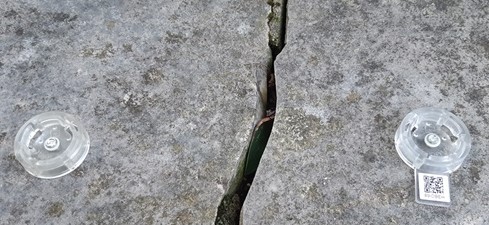
Once the measure has been done, only the transparent plates remain on the stand. Each pair of plates supplied has a QR code and a unique identifier so that measurements can be tracked using the Saugnac.app application supplied.
The digital crackmeter caseThe E1 gauge is supplied in a quality case for easy storage and transport, with :
– a 1-axis installation template – a 2-axis installation template – 5 pairs of P1E1 plates with impact anchors for monitoring 5 cracks on 1 axis – detailed instructions
|
How to fix the plates?The plates are fixed on either side of the crack and are used to position the E1 gauge during measurement. The digital crackmeter plates are transparent and therefore not very visible. They are less than 10mm thick, which means they take up very little space. The PA12 material used guarantees high resistance to weathering (rain, UV) without deterioration.
Fixing is mechanical, using the 4mm impact anchors supplied. The plates are manufactured with a Ø 4mm hole in the centre: these holes make it easier to fix them mechanically using impact anchors. Ø4 mm holes 30 mm deep must be drilled at the marks obtained with the installation template supplied. The 4 mm diameter makes it easy to drill the hole on any surface. Simply pass the impact anchors through the plate into the hole, tap with a hammer, then finalise with the PZ1 screwdriver. A Bosch SDS Ø4 mm drill bit + Stanley PZ1 screwdriver set is available to make installation easier. It is also possible to glue the plates in place using fast-curing epoxy glue. This fast-setting adhesive can be fixed in 4 minutes, but as the final set time is 2 hours, you should wait until then to take the first measurement to ensure that the plates can no longer move. As the resolution of the E1 gauge is one hundredth of a mm (0.01mm), the repeatability of the measurement to one hundredth depends on the quality of the fixing. |
How do you measure the evolution of a 1-axis crack using an electronic crack monitor ?Tracking a single-axis crack with the E1 crackmeter is simple. 1 – Fixing the pair of electronic crack-monitoring platesFirst of all, the pair of 1 axis plates (P1E1) must be fixed on either side of the crack (see above). 5 pairs of P1E1 plates for 1-axis tracking are supplied with the E1 gauge, and boxes of 5 pairs of P1E1 plates can be purchased for further tracking. 2 – Zeroing the digital fissurometer in the standard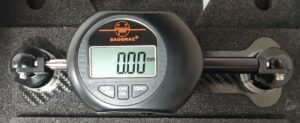
Then the crackmeter must be zeroed on the standard supplied: the E1 electronic crackmeter works by comparative measurement against a standard supplied. Always zero the gauge on the standard before taking a measurement on the plates. We recommend carrying out this operation directly in the case so that the standard lies flat.
3 – Taking the measurement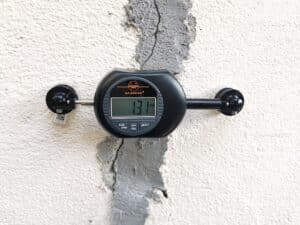
Then position the crackmeter in the plates and take the measurement. The difference between two measurements will be used to calculate the evolution of the movement.
4 – Easily monitor the evolution of the crackMeasurements can be easily tracked using the Saugnac.app application. Each plate supplied has a unique QR code that enables measurements to be traced by associating a measurement history with a plate. |
How do you measure a crack in a corner?The E1 gauge’s fastening system allows it to be fitted in corners. The installation template supplied for tracking on 1 axis can be used to determine the reference points for fixing at an angle. Simply position the gauge in the plates to read the measurement and transfer the values to the Saugnac.app application.
|
How do you measure a crack on 2 axes (gap + shear)?
To monitor a crack or movement of this type, use the E1 gauge combined with P2E1 plates for 2-axis tracking and the Saugnac.app application to perform the calculations. The P2E1 plates are similar in terms of operation to the P1E1 plates (identical fixing and positioning) but are supplied in triplicate (3 plates). Using the 2-axis template supplied, the P2E1 plates are fixed at the 3 points A, B and C. Measurements AB, AC and BC will be taken the first time. The next measurements will be taken only on the lengths AB and AC (BC does not vary).
The Saugnac.app application can be used to project these values into an orthonormal X,Y reference frame and to deduce the movement on these 2 axes. To clearly identify the corresponding X,Y reference frame, it is shown on the template. We recommend that you take a photo of the plates with the template in front of you to clearly identify plates A, B and C as well as the X,Y axes, to facilitate further measurements and interpretation. Any position is possible (vertical, horizontal, oblique or angled crack), by positioning the template according to the crack. Example of positioning the gauge and plates to follow an angled crack on 2 axes:
|
Download the Saugnac.app application to monitor your measurementsThe Saugnac web application, which is completely free with no restrictions, is available on PC or smartphone from https://saugnac.app. Thanks to the unique identification of each pair of P1E1 plates (for 1-axis tracking) or triplet of P2E1 plates (for 2-axis tracking), it is possible to associate measurements with each survey point. The application allows you to :
– save measurements in your space Find out more about how the application works |
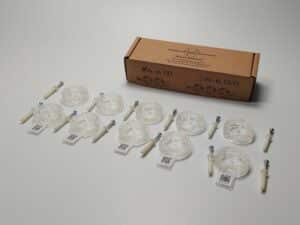
Box of 5 pairs of 2 P1E1 plates for tracking on 1 axis. Accessories for E1 gauge.
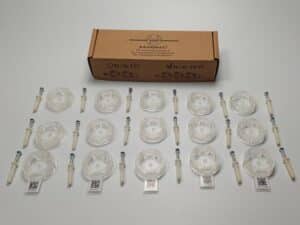
Box of 5 triplets of 3 P2E1 plates for 2-axis tracking. Accessories for E1 gauge.
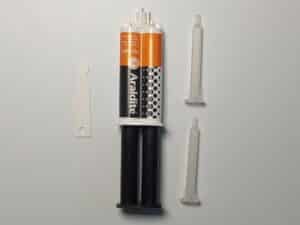
Fast-curing epoxy adhesive in a twin-syringe for reinforced bonding in cases of significant surface roughness or high moisture
Pour obtenir un devis ou nous poser des questions sur le produit, n’hésitez pas à nous contacter :
If you would like a quotation or have any questions about the product, please contact us: